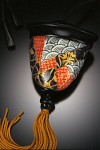Gibson Cuff Bracelets
Gwen Gibson, Kabuki II Bracelet, 2002
Polymer, Lazertran image transfer, gold acrylic paint
Gwen Gibson has spent much of her artistic career creating wearable art. Long interested in surface design, Gwen’s initial approach to polymer was through the eyes of a painter. Because of this perspective, she sought out new directions with the medium. Her implementation of screen printing as well as various means of image transfers onto flat sheets of polymer easily relate back to her experiences with painting, graphics and textiles.
Gwen Gibson, Fractured Traditions, 2001
Polymer, silk screen, gold and silver acrylic paint
Beyond these practices, Gwen’s polymer work reveals her distinct style. She has a decided affinity for Asian and ancient art. Although these artistic influences might appear very different, they share a tendency towards strong patterning and the use of a simplified, flattened picture plane. Always intrigued by that what she does not know, Gwen speaks about her particular “preoccupation with Japanese prints” as “a response to their combination of mystery and bold execution.”
These traits and techniques are evident in a group of Japanese inspired cuff bracelets from 2001-2002.
Gwen Gibson, Japanese Comic Strip Bracelet, 2002
Polymer, silk screen, acrylic paint
In her Japanese Comic Strip Bracelet, pictured above, Gwen presents details from traditional Japanese art in a decidedly contemporary manner. Vibrant screened images in an old-fashioned print style and scratchy, antique looking calligraphy appear against brightly pigmented background fields that evoke the colors of modern day Japanese comic strips. Gwen writes that she “was looking for a more playful approach to using imagery borrowed from another culture.” The combination of intense, contrasting complementary colors with the distinctly older imagery and calligraphy is surprising and even a bit irreverent. This juxtaposition of the antique with a contemporary color scheme conflates two very different moments in time into a single work of art.
Gwen Gibson, Beauties of the Floating World Bracelet, 2002
Polymer, image transfer, acrylic paint
Unlike the lighthearted spirit of the Japanese Comic Strip Bracelet, the Beauties of the Floating World Bracelet, which depicts images of women and strips of relatively large calligraphy, implies a sense of great intimacy. Using transfer techniques augmented with pigment, Gwen employs a limited color scheme more consistent with our sense of traditional Japanese prints. The tight cropping around the women’s heads not only brings to mind our understanding of Japanese spatial esthetics, but is crucial to projecting the feeling of closeness. Moreover, each woman appears to be wearing a more casual style of dressing gown rather than a formal kimono. While perhaps too subtle a detail to be noted, the private nature of their clothing is further suggested by the deep indigo hue, the customary color of Japanese bathing robes.* With this bracelet, a viewer is invited to observe the quieter, more personal moments of each woman’s day.
Gwen Gibson, Kabuki I Bracelet, 2002
Polymer, Lazertran image transfer, acrylic screen print
In a third bracelet portraying Kabuki actors, Gwen achieves yet another effect. Here, transferred images of different performers appear between narrow tiles ornamented with an eye-catching, screened lattice pattern. We see the figures from a more removed point of view than that of the women above. Thin stripes of red define the edges of the tiles and add a further dramatic accent. Gwen’s use of black, white and red also conveys an impression of strength relative to the other two bracelets. The visual rhythm of the images, edged in stark graphic color and punctuated with panels of pattern, is very distinctive and might serve as a metaphor for different moments in time- be they within a scene, a play or a battle.
These three bracelets share common techniques and Japanese motifs, but present unique statements. Each one reveals a different insight into Gwen’s perception of Japanese art and culture while thoroughly blending the past with the present via materials and interpretation.
*The yukata had a bath house origin, but evolved into a style of casual dress. Susanna Kuo, Carved Paper: The Art of the Japanese Stencil, Santa Barbara Museum of Art, 1998 pp.28-29




